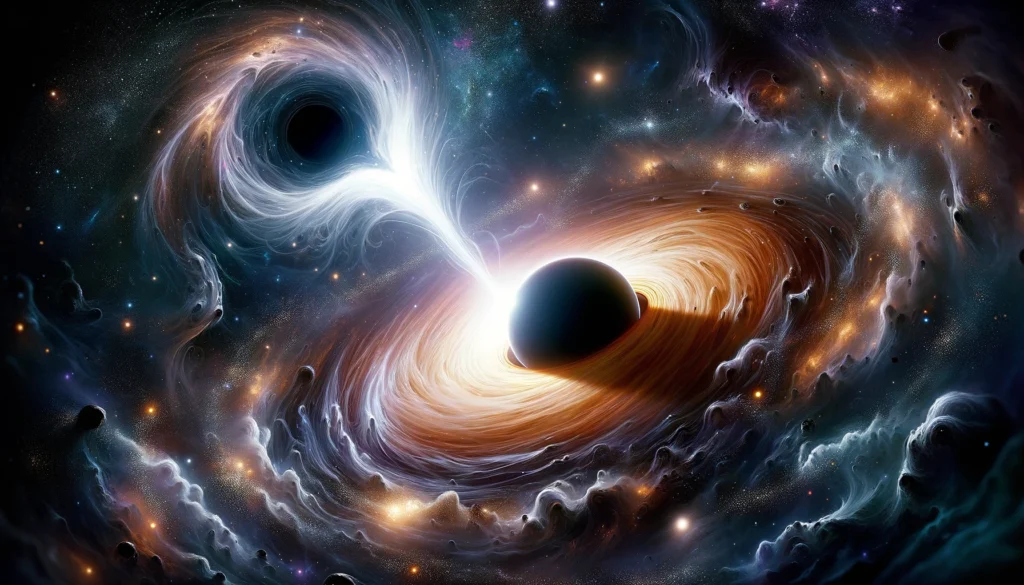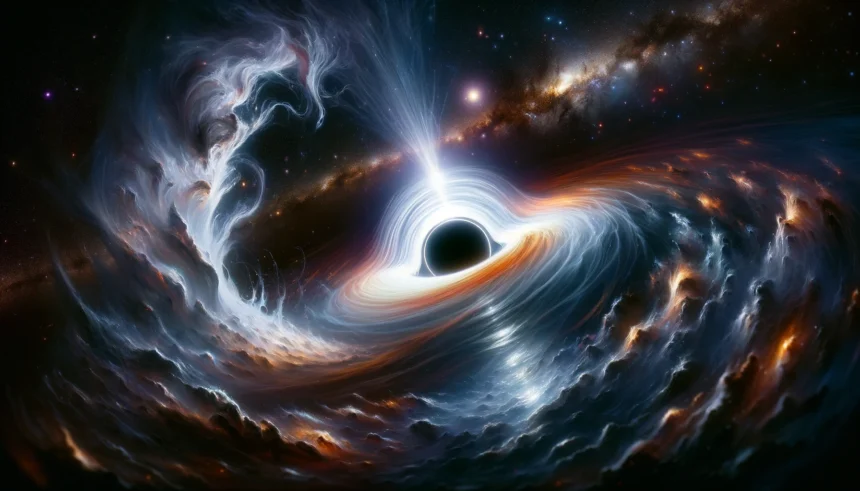White holes are hypothetical cosmic areas that work in the opposite direction of black holes. Nothing can escape or enter a white hole, just as nothing can escape or enter a black hole. White holes were long assumed to be a creation of general relativity, arising from the same equations as their collapsing star cousins, black holes.
However, some theorists have lately speculated that these dual spacetime vortices may be two sides of the same coin.
●⫸ What is a White Hole?
A white hole seems identical to a black hole to a spacecraft crew looking from afar. It has weight. It has the potential to spin. Around the event horizon — the bubble boundary separating the particle from the rest of the cosmos — a ring of dust and gas might form. The crew could notice something that a black hole can’t: a belch if they keep their eyes peeled.
It is a strange cosmic entity that shines brightly and gushes stuff rather than disappearing. It’s the polar opposite of a black hole, to put it another way. Unlike black holes, however, there is no agreement on whether or not white holes exist or how they develop.
A white hole is the “time-reversal” of a black hole, or a movie of a black hole played backward, in the same way as a bouncing ball is the time-reversal of a falling ball. While the event horizon of a black hole is a sphere of no return, the event horizon of a white hole is a border of no admittance – space-most time’s exclusive club. There will never be a spacecraft that can reach the region’s boundary.

Read More:
●⫸ Are White Holes Real?
Objects within a white hole can leave and interact with the outside world, but because nothing can get in, the interior is shut off from the past of the universe: no outside events will ever impact the inside. “Having a singularity in the past that may affect everything in the outer world is more disturbing,” said James Bardeen, an emeritus professor at the University of Washington and a black-hole pioneer.
They are predicted by Einstein’s theory of gravity and are most usually discussed in the context of ‘wormholes,’ in which a black hole acts as the entry point to a space-time tunnel that leads to a white hole anywhere in the Universe.
Some theorists, on the other hand, believe that combining Einstein’s theory with quantum theory would lead to a new way of thinking about white holes. They might be a slow-motion replay of the initial black hole’s development, rather than an ‘exit’ from a wormhole.
●⫸ How are White Holes formed?
When astrophysicists use mathematics to examine the environment around black holes, they assume there is no mass within the event horizon, resulting in white holes. When a black hole singularity has no mass, what happens? The mathematical principles of white holes are entirely speculative.
Indeed, I’ve been informed that disregarding the mass of the singularity makes things a lot easier for those who work on black hole mathematics. They don’t exist in the real world. It’s not as though scientists discovered a strange burst of radiation and then concocted fictitious white hole models to explain it.
●⫸ What would happen if Black Hole and White Hole collide?
Despite its differences, the white hole is equally as destructive as, if not more so than, a black hole. The stuff ejected by the white hole travels at the speed of light. As a result, it’s reasonable to argue that the white hole, as opposed to this up-and-coming black hole, is the more experienced combatant in this position.
But how useful will its experience be?
Our two adversaries eventually meet after millions of years of wreaking havoc over the Universe. They’ve fought asteroids, planets, and even stars, but have always come out on top. Now they’re up against their most formidable foe yet. The black hole will gain the upper hand as these two immense forces approach one other.
It will try all in its power to keep the black hole from catching up to it. But, regrettably, it doesn’t have a chance. Because the white hole has no choice but to spit energy towards its foe, this is the case. Despite its ability to protect itself against everything else in the Universe, the black hole is tragically its only real match.
The matter ejected by the white hole is converted into energy by the black hole. The black hole may feed on the white hole for thousands of years, so this won’t be a fast fight. And the black hole is getting bigger and bigger as it feeds.

The black hole is now prepared for the last blow. The white hole is fully swallowed. Our black hole has grown in size as a result of the tremendous amount of energy it has swallowed.
It might be as massive as Messier 87, which spans 38 billion kilometers (23.6 billion miles). For context, that’s 3 million times the size of Earth. If a white hole and a black hole clash, a gigantic black hole would be created that would annihilate everything in its path.
●⫸ Conclusion:
In theory, a black hole singularity would shrink to the lowest size feasible according to physics. It would then resurface as a white hole. However, because of the enormous time dilation effect that exists near a black hole, even the smallest ones would take billions of years to eventually explode.
If microscopic black holes formed after the Big Bang, they may disintegrate and explode as white holes at any point. According to Stephen Hawking, they would have vanished by now.
A white hole, another interesting idea offered by scientists, might explain the Big Bang since it is yet another case in which a vast amount of matter and energy suddenly created. Most white holes are probably just difficult math issues. Because fancy math seldom survives contact with reality, white holes are likely imaginary.






I am sorry, that has interfered… I here recently. But this theme is very close to me. Write in PM.
_ _ _ _ _ _ _ _ _ _ _ _ _ _
Nekultsy Ivan perfect hosting